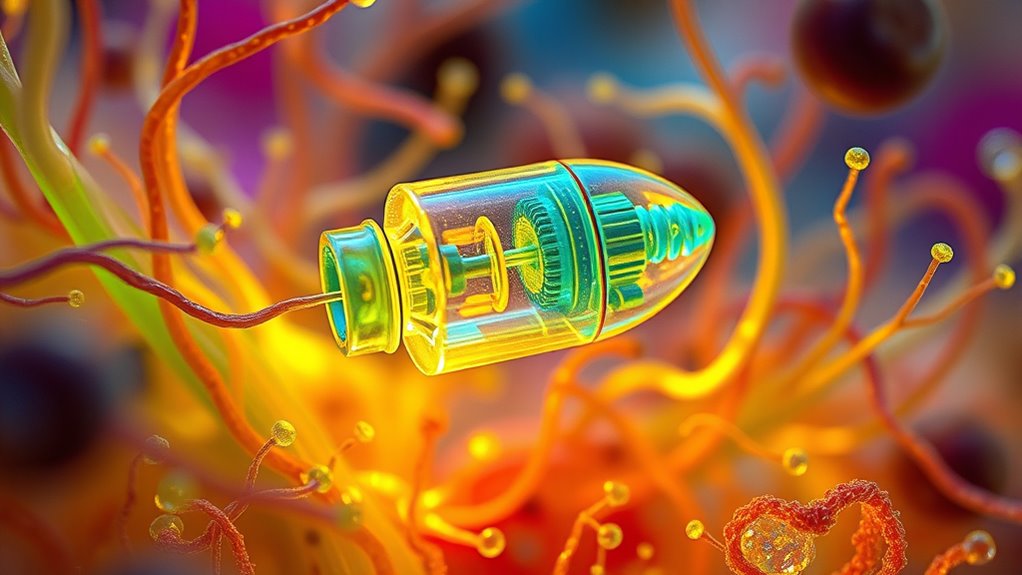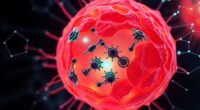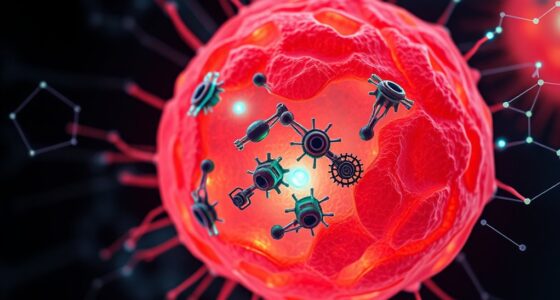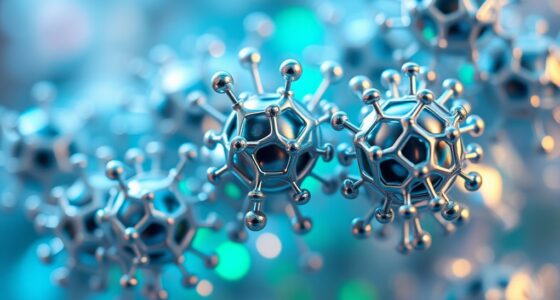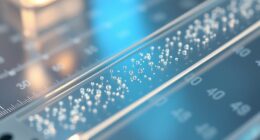Targeted drug delivery with nanomachines involves using microscopic devices designed to recognize specific disease markers, navigate the biological environment, and release drugs precisely where needed. These nanomachines can attach to cells, penetrate tissues, and respond to stimuli like pH or enzymes for controlled release. This approach offers promising benefits, such as increased treatment accuracy and fewer side effects. Keep exploring to discover how these tiny machines are revolutionizing personalized medicine and future healthcare.
Key Takeaways
- Nanomachines recognize disease markers and attach selectively to target cells for precise drug delivery.
- Engineered surface ligands or antibodies ensure high-affinity binding to specific cellular receptors.
- Stimuli-responsive nanomachines release drugs in response to pH, enzymes, or external triggers at the target site.
- Nanocarriers can navigate through biological barriers, evading immune detection for effective tissue penetration.
- Integration of AI enhances targeting accuracy, navigation, and controlled drug release for personalized therapies.
The Science Behind Nanomachines in Medicine

Nanomachines in medicine operate through precisely engineered components that can perform specific tasks at the cellular level. You’ll find these tiny devices designed with incredible accuracy, allowing them to navigate your body’s complex systems. They use molecular components like proteins, DNA, or synthetic materials to recognize and interact with targeted cells. This precision enables nanomachines to identify disease markers, attach to specific cells, and deliver drugs exactly where needed, reducing side effects. Their operation often relies on energy sources such as chemical reactions or external stimuli like magnetic fields. By functioning at such a small scale, nanomachines can penetrate tissues and cellular barriers that traditional treatments can’t reach. This scientific foundation offers the potential for highly effective, personalized therapies that transform modern medicine.
Designing Nanomachines for Precision Targeting
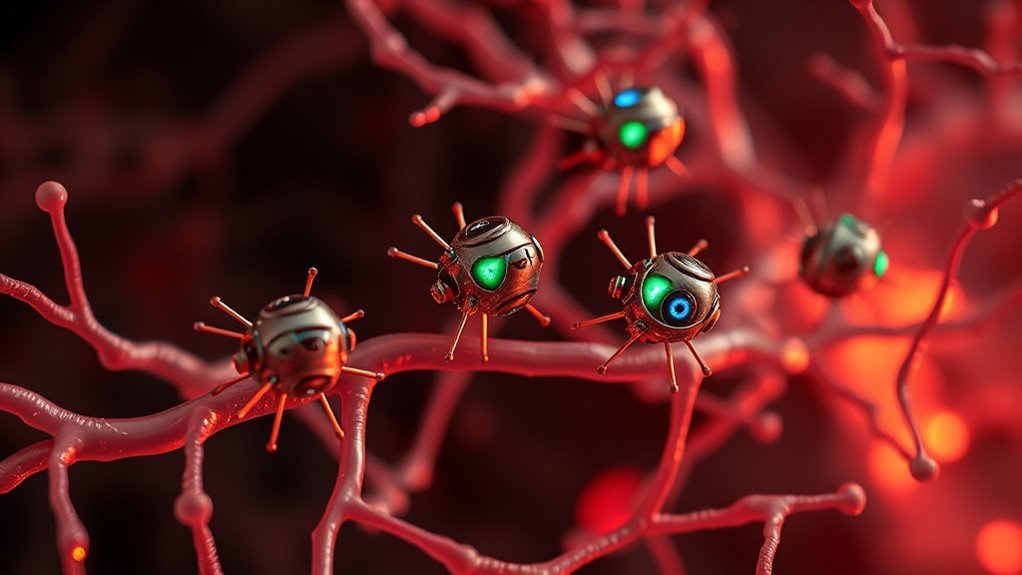
Designing nanomachines for precision targeting involves carefully selecting and arranging molecular components to guarantee they can accurately recognize and bind to specific cells or tissues. You start by identifying unique markers, such as proteins or receptors, on your target cells. Then, you engineer surface ligands or antibodies that specifically bind to these markers, ensuring high affinity and specificity. Incorporate responsive elements that activate only in certain environments, like pH or enzyme presence, to enhance targeting accuracy. Stability is essential, so you choose materials resistant to degradation until they reach their destination. You also design for minimal off-target interactions, reducing side effects. By combining these strategies, you create nanomachines that deliver drugs precisely where needed, maximizing efficacy and minimizing harm.
Paint Sprayer Reviews & Buying Guides
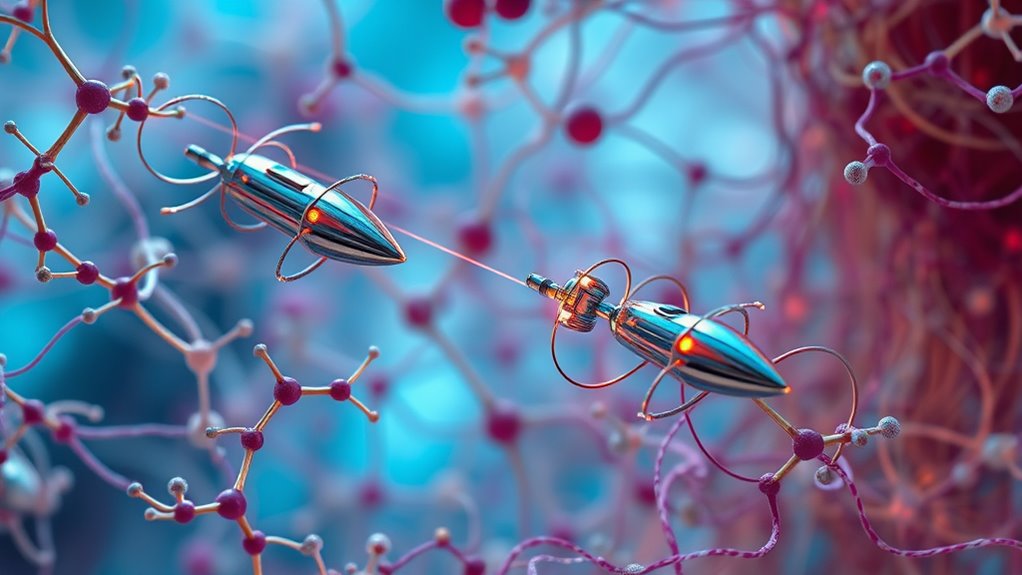
After successfully engineering nanomachines to recognize and bind to specific targets, the next challenge lies in steering the complex and dynamic biological environment. Your nanomachines must navigate bloodstream obstacles, immune responses, and tissue barriers. These factors can divert or destroy them before reaching the target. To overcome this, you can incorporate stealth features like surface coatings to evade immune detection or design flexible structures to maneuver through tight spaces. Understanding the environment’s variability is vital for success. Here’s a quick overview:
| Challenge | Solution |
|---|---|
| Immune system detection | Use biocompatible coatings |
| Blood flow and turbulence | Design flexible, adaptive structures |
| Tissue barriers | Incorporate targeting ligands and navigation cues |
Mechanisms of Drug Release and Control
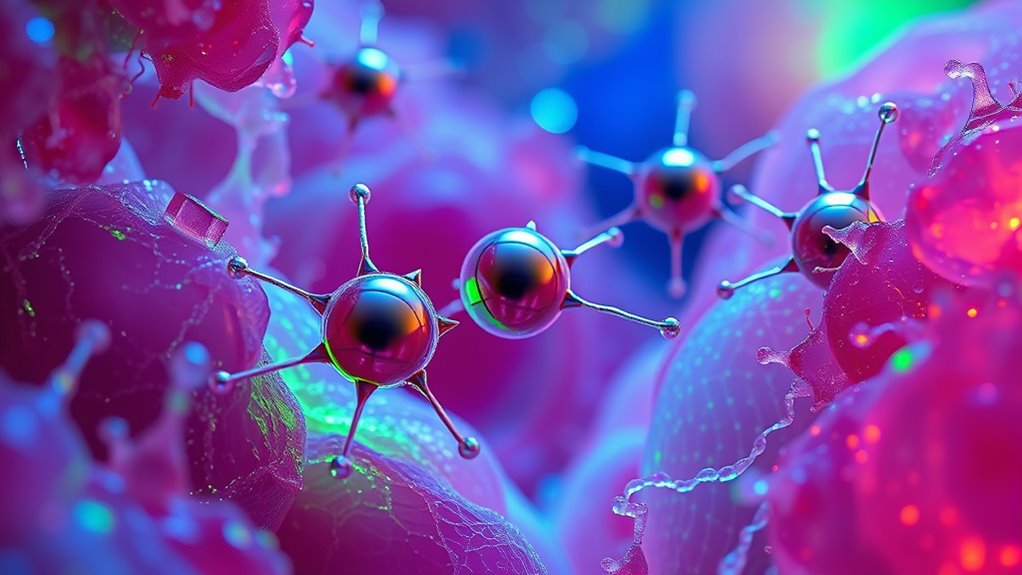
Effective drug release and control are essential for ensuring that therapeutic agents act precisely where needed, minimizing side effects. Nanomachines use various mechanisms to achieve this, allowing you to fine-tune drug delivery. For instance, they can respond to specific stimuli, such as pH changes, temperature shifts, or light exposure, triggering drug release only in targeted areas. You might also rely on enzyme-sensitive systems that activate when encountering certain biological markers. Additionally, nanomachines can be programmed for sustained release, maintaining therapeutic levels over time, or for rapid release when immediate action is required. These mechanisms guarantee precise control, reducing unnecessary exposure elsewhere. Moreover, understanding AI vulnerabilities helps in designing more secure nanomachines that prevent unintended activation or malicious interference. By understanding these control methods, you can optimize treatment efficacy and safety, making nanomachines a revolutionary step forward in personalized medicine.
Current Technologies and Materials Used in Nanomachines
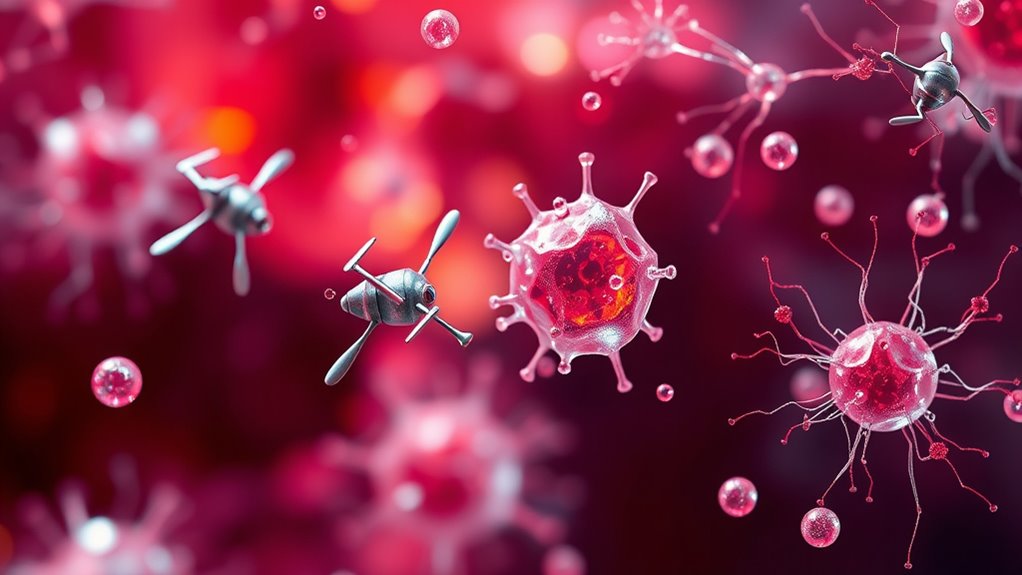
Advancements in nanotechnology have led to the development of diverse materials and systems that power nanomachines for drug delivery. You’ll find that inorganic materials like gold and silica are popular due to their stability, ease of functionalization, and biocompatibility. Magnetic nanoparticles enable external control using magnetic fields, allowing precise navigation to target sites. Organic materials, such as lipids and polymers, form nanocarriers like liposomes and polymeric nanoparticles, which can encapsulate drugs and release them in response to specific stimuli. Additionally, carbon-based nanomaterials like graphene and carbon nanotubes offer high surface area and unique electrical properties, useful for sensing and controlled release. Together, these materials and technologies provide a versatile toolkit for designing effective, targeted nanomachines for drug delivery applications.
Potential Benefits and Risks of Targeted Delivery
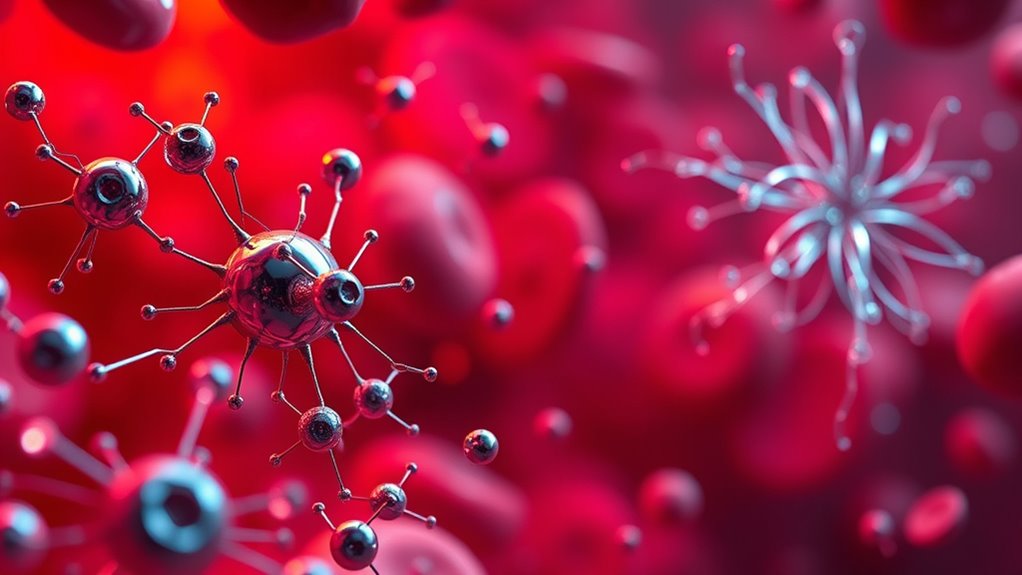
Targeted drug delivery with nanomachines offers significant benefits, such as increasing treatment precision and reducing side effects. You can deliver medication directly to diseased cells, sparing healthy tissue and improving outcomes. However, risks exist too. Potential issues include unintended interactions with the body, immune system responses, and challenges in controlling nanomachines once inside the body. You should also consider the possibility of toxicity if materials aren’t fully biocompatible, or if nanomachines accumulate unexpectedly. Color accuracy and precise calibration are also crucial factors influencing the effectiveness of nanomachine-based therapies. Off-target effects could harm healthy cells. Immune reactions might cause inflammation. Long-term toxicity risks remain uncertain. Ethical concerns about nanoscale manipulation.
Future Directions and Emerging Trends in Nanomedicine
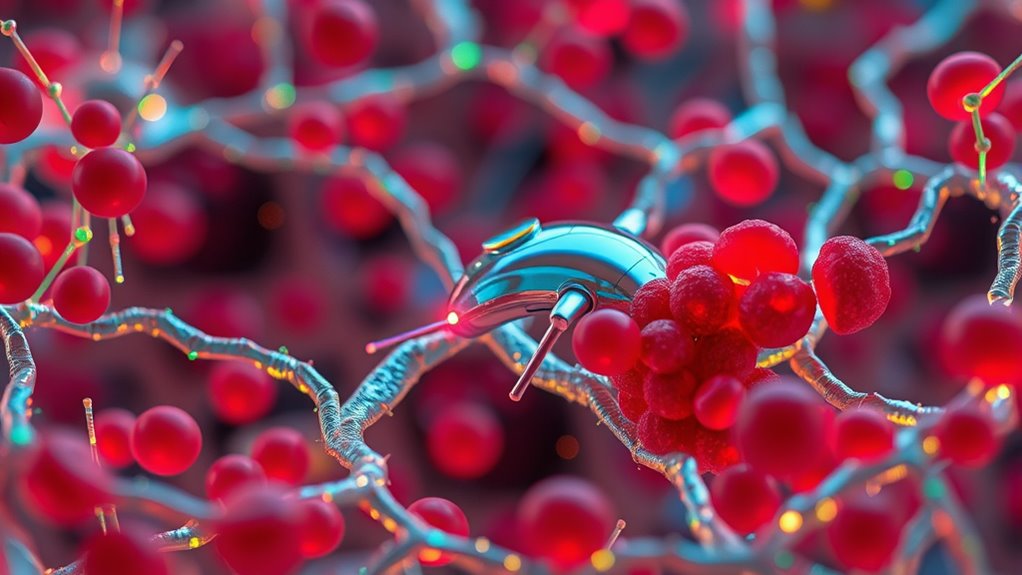
Future trends in nanomedicine will likely focus on personalized treatment strategies that tailor therapies to individual patients. You’ll see increased integration of artificial intelligence to optimize nanomachine design and delivery methods. These advancements promise more effective, targeted options with fewer side effects, transforming healthcare as you know it. Additionally, ongoing research into ethical considerations will be essential to ensure responsible development and deployment of these emerging technologies.
Personalized Treatment Strategies
As nanomedicine evolves, personalized treatment strategies are becoming increasingly central to optimizing patient outcomes. You can now tailor therapies based on individual genetic profiles, disease markers, and responses, ensuring more effective and targeted interventions. This approach reduces side effects and improves efficacy by delivering drugs precisely where needed. With nanomachines, you gain the ability to customize drug release mechanisms, dosages, and targeting ligands. Key trends include:
- Developing nanodevices that adapt to real-time biological signals
- Using patient-specific biomarkers to guide therapy
- Designing multifunctional nanocarriers for combination treatments
- Integrating diagnostics within nanomachines for immediate feedback
- Employing ethical hacking principles to safeguard these complex systems from malicious interference
These advancements enable you to create truly personalized, adaptive treatment plans that evolve with your patient’s condition.
Integration With AI
Integrating artificial intelligence with nanomedicine is revolutionizing how you design and deploy nanomachines for drug delivery. AI enables real-time data analysis, optimizing targeting accuracy and response times. Machine learning algorithms predict disease progression, allowing nanomachines to adapt dynamically. This synergy facilitates autonomous navigation, reducing human intervention. The table below highlights key AI-driven advancements transforming nanomedicine:
| Innovation | Benefit | Impact |
|---|---|---|
| Predictive Analytics | Better targeting accuracy | Reduced side effects |
| Autonomous Navigation | Precise movement within body | Improved delivery efficiency |
| Real-time Monitoring | Continuous treatment adjustments | Enhanced patient outcomes |
| Adaptive Algorithms | Personalized treatment plans | Increased efficacy |
| Data Integration | Holistic patient data analysis | More informed decisions |
This integration accelerates nanomedicine’s evolution, promising smarter, more effective therapies. Advancing precision medicine
Ethical and Regulatory Considerations
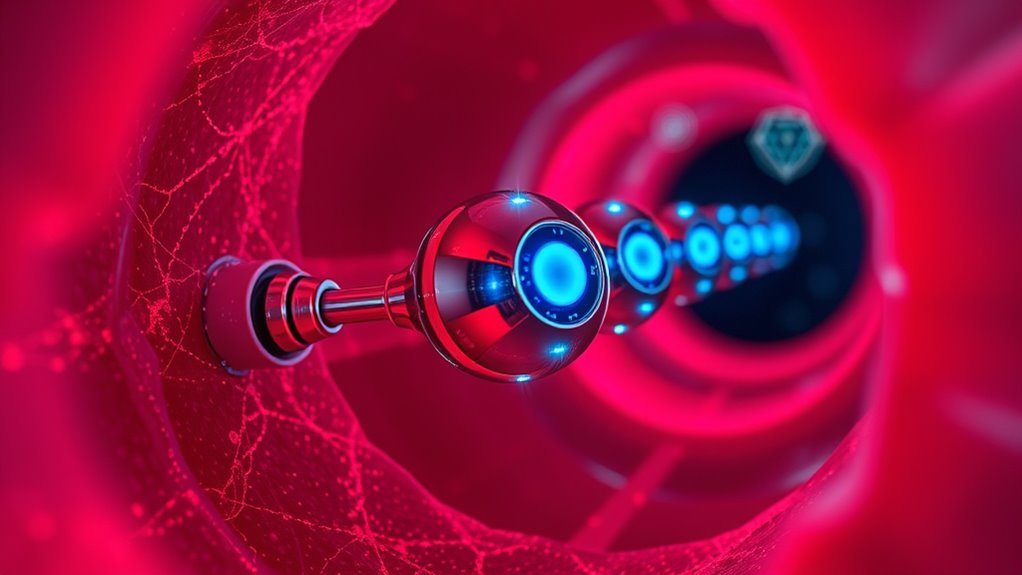
When developing nanomachines for drug delivery, you need to ensure safety and risk assessments to protect patients. Regulatory approval processes ensure these technologies are thoroughly evaluated before widespread use. Additionally, you must address ethical concerns about the responsible and fair application of nanotechnology in medicine. Incorporating security measures is essential to safeguard sensitive data and maintain public trust in these innovative treatments.
Safety and Risk Assessment
Ensuring the safety of nanomachines in targeted drug delivery raises complex ethical and regulatory questions that cannot be overlooked. You need to evaluate potential risks to patients, the environment, and long-term health effects. Consider the following aspects:
- Possible toxicity or unintended interactions within the body
- Long-term accumulation or bioaccumulation of nanomaterials
- Risks of malfunction or uncontrolled behavior
- Environmental impact if nanomachines are released or discarded
- The potential for adverse reactions due to the interaction of nanomaterials with delicate tissues, such as the skin around the eyes, which require careful assessment of skin compatibility. You’re responsible for implementing thorough testing protocols, monitoring safety data, and establishing guidelines to prevent harm. Balancing innovation with caution is critical to gaining public trust and regulatory approval. Addressing these safety concerns proactively helps make certain that nanomachines deliver benefits without unforeseen consequences.
Regulatory Approval Processes
Managing the regulatory approval process for nanomachines in targeted drug delivery requires careful consideration of ethical standards and safety protocols. You’ll need to work closely with agencies like the FDA or EMA, providing extensive data on manufacturing, safety, and efficacy. This involves demonstrating that your nanomachines meet strict quality controls and do not pose unforeseen health risks. This process also necessitates ongoing active listening and empathy to address concerns from regulators and stakeholders effectively. You should prepare detailed documentation, including preclinical and clinical trial results, to prove your technology’s safety profile. Steering through this process can be complex, as regulators evaluate not just the device itself but also its long-term effects and environmental impact. Staying transparent, maintaining rigorous standards, and adhering to evolving guidelines will be key to gaining approval and bringing your innovations to market responsibly.
Ethical Use of Nanotech
As nanotechnology advances in targeted drug delivery, addressing ethical considerations becomes essential to guarantee responsible development and use. You need to think about potential risks, like unintended side effects or long-term environmental impacts. Respecting patient privacy and obtaining informed consent are critical as nanotech becomes more integrated into healthcare. You should also consider equitable access—ensuring everyone benefits, not just a select few. Additionally, transparency in research and clear regulations help build public trust and prevent misuse. Implementing security measures is vital to protect sensitive data and prevent malicious use of nanomachines.
Frequently Asked Questions
How Cost-Effective Are Nanomachine-Based Drug Delivery Systems?
Nanomachine-based drug delivery systems can be cost-effective over time because they target treatments precisely, reducing drug waste and minimizing side effects. Although initial development and manufacturing costs are high, their efficiency can lower overall healthcare expenses by improving patient outcomes and decreasing hospitalization rates. You might find that, as technology advances and scales up, these systems become more affordable, making personalized medicine more accessible and affordable for many patients.
Can Nanomachines Be Personalized for Individual Patients?
Yes, nanomachines can be personalized for individual patients. You can customize their design based on a patient’s specific genetic makeup, disease profile, and treatment needs. This personalization allows for more precise targeting and improved effectiveness. By tailoring nanomachines, you guarantee that the therapy interacts efficiently with the patient’s unique biology, reducing side effects and increasing the chances of successful treatment outcomes.
What Are the Long-Term Stability Concerns of Nanomachines?
You should be aware that nanomachines face long-term stability concerns like degradation, oxidation, and potential loss of functionality over time. These tiny devices might break down or become less effective due to environmental factors inside the body, such as enzymes or immune responses. Ensuring their durability requires advanced materials and protective coatings, so they can perform reliably throughout treatment without causing unintended side effects or losing efficacy.
How Do Nanomachines Interact With the Immune System?
You might worry that nanomachines trigger immune responses, but they’re designed to minimize this. They interact with immune cells by avoiding detection or by being coated with biocompatible materials. Sometimes, your immune system recognizes them as foreign, leading to clearance or inflammation. Researchers are actively working to modify surface properties and use stealth techniques, ensuring nanomachines can perform their tasks without provoking harmful immune reactions.
Are There Any Known Environmental Impacts of Nanomachine Disposal?
Yes, there are concerns about environmental impacts when nanomachines are disposed of. You should know that nanomaterials can accumulate in ecosystems, potentially harming wildlife and disrupting natural processes. They may also be difficult to break down, leading to long-term contamination. Proper disposal methods are essential, and ongoing research aims to develop eco-friendly nanomachine materials to minimize these risks. Staying informed helps you support responsible use and disposal practices.
Conclusion
As you explore nanomachines in medicine, remember how innovation often emerges from unexpected places—nature’s own tiny engineers. With each breakthrough, you get closer to precise treatments that could transform healthcare. But as you embrace these advancements, stay mindful of the risks and ethical questions that come with such groundbreaking technology. Ultimately, your role in shaping the future of nanomedicine is essential, turning coincidence into a catalyst for life-changing discoveries.
